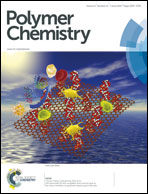Rapid analysis of polyester and polyethylene blends by ion mobility-mass spectrometry
Abstract
In this work ion mobility-mass spectrometry (IM-MS) coupled to an atmospheric solid analysis probe (ASAP) was used for the characterization of polymer blends involving biodegradable polymers (poly(lactic acid) (PLA), poly(butylene succinate) (PBS)) and poly(ethylene) (PE). Interestingly both PLA and PBS yielded by ASAP an ionization ion series corresponding to cyclic oligomers that were nearly identical to those obtained by conventional Py-GC-CI/MS. However from the drift-time vs. m/z plot of a PLA–PE blend, the ion series of both polymers can be readily identified, as the PLA ions are significantly more compact than the PE ions. From this 2D plot specific mass spectra can be extracted which are almost identical to those of each polymer alone. This work highlights the potential of ASAP–IM-MS to achieve a very fast analysis of complex polymer blends. It was demonstrated that coupling gas phase ion separations (IM) with direct and weakly discriminant ionization techniques (ASAP) significantly enhances the dynamic range of accessible concentrations and polymer polarities, opening a new avenue to carry out more complex “materiomics” studies.


 Please wait while we load your content...
Please wait while we load your content...